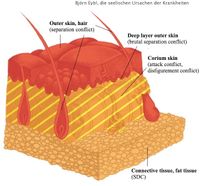Vitiligo, gray hair
Also see outer skin and hair loss.
Sensitivity follows the outer skin pattern.
Whether it involves the left or right side of the body depends on the biological laterality of the person.
Themes
Separation conflicts
- Vitiligo: cruel, ugly, painful separation. For example this message, "Your father died in a car accident, his head was completely shattered."
- Gray hair: the separation has a generational aspect, separation from a family and/or offspring.
Own observation: there are distinct periods when the degree of graying increases:
- When the children go leave the house, that is, between the ages of 40 and 50: in a relatively short time much more "salt and pepper."
- When one's own generation begins to fall away, that is, in old age: one becomes "white" in a relatively short time.
CA phase
(Local) decrease of cells at the underside of the outer skin, where pigment cells are located.
Unlike the top of the outer skin, there is no numbness, but rather a slightly increased sensitivity due to the thinner skin without pigment.
Symptoms
White patches on the skin due to the decrease of pigment cells in those areas. Gray hair due to decreased pigmentation in the hair follicles.
Biological purpose
Attempt to still feel the person from whom one was separated in such a crude way.
PCL phase
Reconstruction of the underside of the epidermis. The white spots usually rebuild from the edge inward.
Symptoms
Swelling, redness and pain, in the PCL-B especially itching.
Scarlet fever occurs when the conflict affects both the underside and the top of the outer skin.
A red and swollen tongue (“raspberry tongue”) indicates an additional “oral conflict” (possibly food-related).
Recognition of a reader:
I, when I was almost 14, saw my father suffer a spinal cord injury and then developed vitiligo. Rather large patches around my hips and beyond knees and ankles. These have indeed returned to the normal skin color, albeit slowly, from the outside. Also dots of pigment in the white spots. Never knew what I am reading now.

